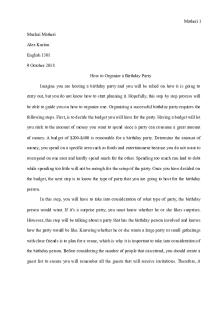1916 - TOA – RELATED PARTY DISCLOSURES PDF

| Title | 1916 - TOA – RELATED PARTY DISCLOSURES |
|---|---|
| Author | Sherilyn Damasco |
| Course | Accountancy |
| Institution | Holy Trinity University |
| Pages | 2 |
| File Size | 95.2 KB |
| File Type | |
| Total Downloads | 274 |
| Total Views | 831 |
Summary
HTU CPA In-House Review (HCIR)Financial Accounting and ReportingTOA – RELATED PARTY DISCLOSURES April G.1. Related parties include all of the following , except a. Affiliates b. Associates c. Individuals owning, directly or indirectly, an interest in the voting power of the reporting entity that giv...
Description
HTU CPA In-House Review (HCIR) Financial Accounting and Reporting TOA – RELATED PARTY DISCLOSURES
April G.
1. Related parties include all of the following, except a. Affiliates b. Associates c. Individuals owning, directly or indirectly, an interest in the voting power of the reporting entity that gives them significant influence over the entity d. Two entities that have a common director 2. Unrelated parties include all of the following, except a. Providers of finance in the course of their normal dealings with an entity by virtue only of those dealings. b. Two ventures simply because they share joint control over a joint ventures. c. Single customer with whom an entity transacts a significant volume of business merely by virtue of the resulting economic dependence. d. Key management personnel 3. Close family members of an individual include all of the following, except a. The individual’s spouse and children b. Children of the individuals c. Dependents of the individual or individual’s spouse d. Brothers and sister of the individual 4. The minimum disclosures about a related party transaction include all of the following, except a. The amount of the transaction b. The amount of outstanding balance c. Allowance for doubtful accounts related to the outstanding balance d. Nature of the relationship 5. Which is not a mandated related party disclosure? a. Relationship between parent and subsidiaries b. Names of all the associates that an entity has dealt with during the year c. Name of the entity’s parent and the ultimate controlling party d. If neither the entity’s parent nor the ultimate controlling entity produces financial statements available for public use, then the name of the next most senior parent that does so 6. Which is not a required minimum related party disclosure? a. The amount of the related party transaction b. The amount of the outstanding balance c. The amount of similar transaction with unrelated parties to establish that comparable related party transactions have been entered into at arm’s length d. Allowance for doubtful accounts related to the outstanding balance 7. An entity that entered into a related party transaction would be required to disclose all, except a. Nature of the relationship between the parties. b. Nature of any future transaction planned between the parties and the terms involved. c. Peso amount of the transaction d. Amount due from or to related parties. 8. Which of the following would not be considered key management personnel compensation? a. Short-term benefits b. Share-based payments c. Termination benefits d. Reimbursement of out-of-pocket expenses 9. All of the following fall within the definition of an entity’s related party, except a. Joint venture in which the entity is a venture b. A post-employment benefit plan for the benefit of the employees c. An executive director of the entity d. The partner of a key manager is a major supplier of the entity 10. Which of the following is not specified as a separate related party disclosure?
1916
Page 1 of 2...
Similar Free PDFs

TOA - TOA
- 9 Pages

AFAR-TOA
- 19 Pages

MKT202 JAN 2021 TOA
- 5 Pages

TOA FAR by Milan
- 241 Pages

Preboard- Reviewer-TOA
- 44 Pages

Deferred Taxes TOA
- 9 Pages

The Garden Party - Analysis
- 3 Pages

Standard Answering Procedure For TOA
- 27 Pages

Batch 18 1st Preboard (TOA)
- 10 Pages

TOA 43 47 - master budget
- 31 Pages

Essay 2 Birthday party
- 4 Pages

the dinner party
- 1 Pages

Political Party Eras
- 2 Pages
Popular Institutions
- Tinajero National High School - Annex
- Politeknik Caltex Riau
- Yokohama City University
- SGT University
- University of Al-Qadisiyah
- Divine Word College of Vigan
- Techniek College Rotterdam
- Universidade de Santiago
- Universiti Teknologi MARA Cawangan Johor Kampus Pasir Gudang
- Poltekkes Kemenkes Yogyakarta
- Baguio City National High School
- Colegio san marcos
- preparatoria uno
- Centro de Bachillerato Tecnológico Industrial y de Servicios No. 107
- Dalian Maritime University
- Quang Trung Secondary School
- Colegio Tecnológico en Informática
- Corporación Regional de Educación Superior
- Grupo CEDVA
- Dar Al Uloom University
- Centro de Estudios Preuniversitarios de la Universidad Nacional de Ingeniería
- 上智大学
- Aakash International School, Nuna Majara
- San Felipe Neri Catholic School
- Kang Chiao International School - New Taipei City
- Misamis Occidental National High School
- Institución Educativa Escuela Normal Juan Ladrilleros
- Kolehiyo ng Pantukan
- Batanes State College
- Instituto Continental
- Sekolah Menengah Kejuruan Kesehatan Kaltara (Tarakan)
- Colegio de La Inmaculada Concepcion - Cebu


